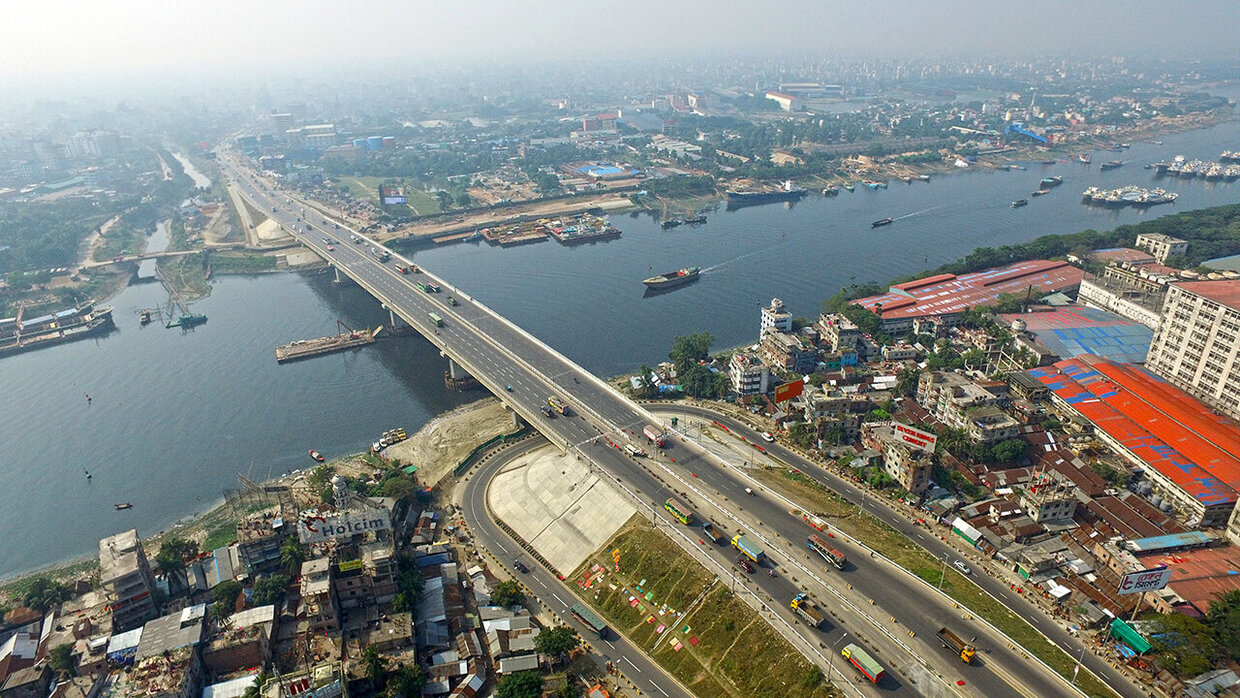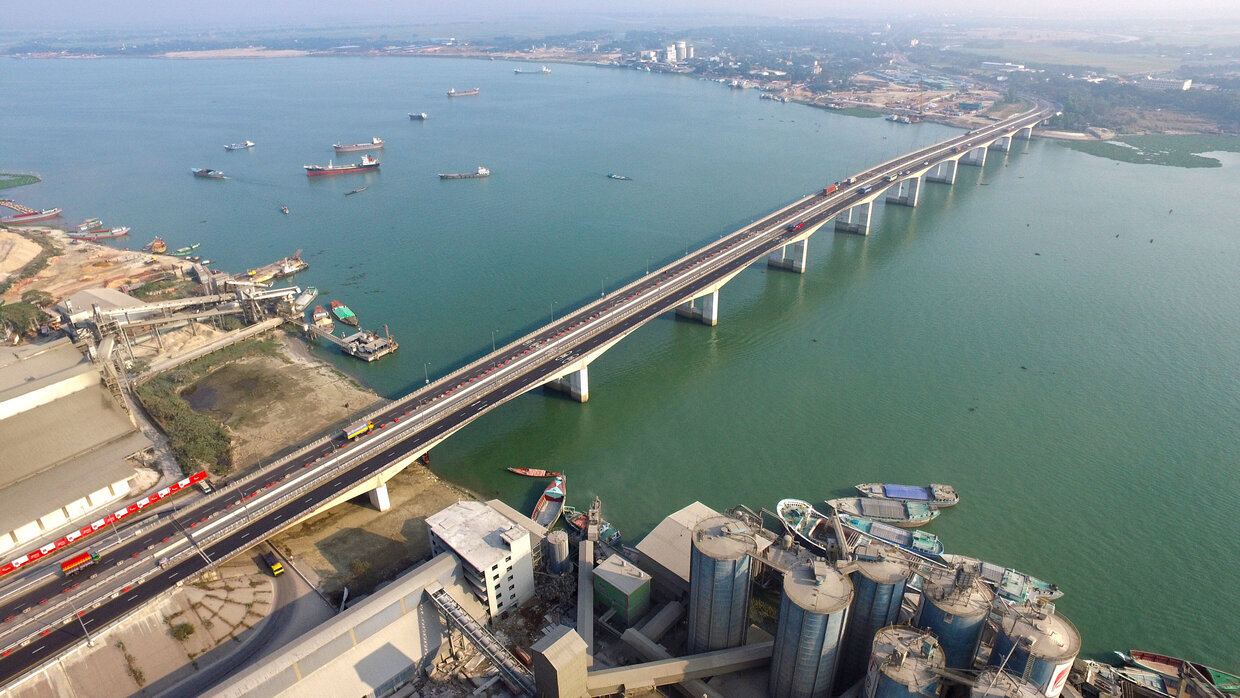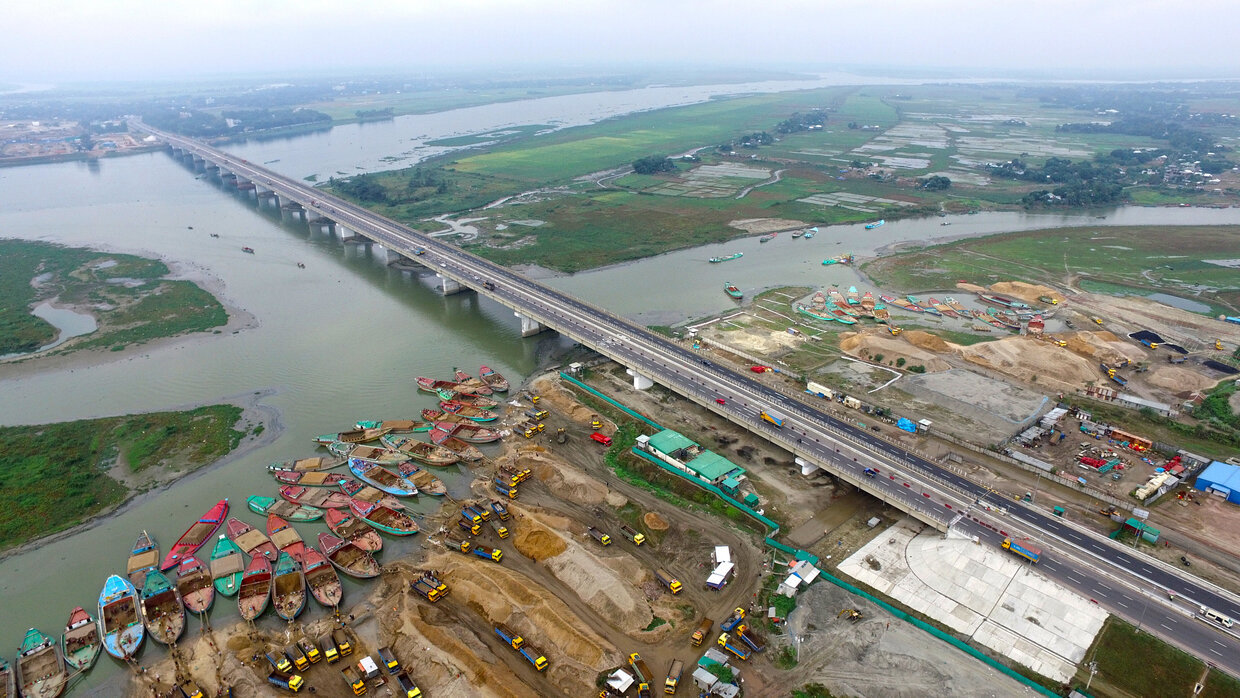Expanding Business Fields (2) Civil Engineering Business
Social Infrastructure Improvement—Large-Scale Projects Enter Full Swing
Amidst the growing threat posed by earthquakes, successive landfall of large-scale typhoons, and other natural disasters, broad efforts have been made across society to prevent and mitigate disasters, address the issue of aging infrastructure, and build national resilience as ways of protecting people’s lives and livelihoods. Progress has also been made toward the seismic retrofitting and reinforcement of road and railway bridge piers, dam construction for flood control, and river improvements. Meanwhile, there is also a heightened need to create a new social foundation that can help people live safe and fulfilling lives. Therefore, the construction for next-generation transportation networks were planned, such as the installation and extension of new expressways and the Chuo Shinkansen Maglev Line.
Obayashi Corporation worked to build and extend the life of these types of infrastructure, with the company taking on a pioneering role in areas of construction that require advanced levels of technical and management ability, such as maintaining and updating highways while they are in use, in addition to constructing high-speed ring roads by deep and ultra-long-distance TBM (tunnel boring machine) tunneling.
An example of such project is the construction project of the largest section of the main tunnel connecting the Oizumi and Tomei Junctions on the Tokyo Outer Ring Road, which was contracted in April 2014. Making use of the deep area available underground, a nine-kilometer-long highway tunnel was built using a TBM with a diameter of 16 meters; the largest in Japan. The company leveraged the tunneling techniques it had accumulated through the Tokyo Bay Aqua-Line and Metropolitan Expressway Central Circular Shinjuku Line construction projects to carry out the works. Highway ramps and other related construction works were also contracted at this time.
As part of construction works at the section of the Shin Tomei Expressway between the Hamamatsu-Inasa and Toyota-Higashi Junctions, which was opened in February 2016, the company constructed multiple tunnels and bridges in Aichi Prefecture. The project brought the total length of the opened section—which also includes the section in Shizuoka Prefecture that had already been opened—to approximately 200 kilometers. Creating a dual transportation network has alleviated congestion along the Tomei Expressway and contributed to swift recovery in the event of a large-scale natural disaster. It has also led to strengthened cooperation between the three large metropolitan regions of Tokyo, Osaka, and Nagoya. Construction connected with the Shin-Meishin Expressway involved taking responsibility for the construction of the Nonobori tunnel (4.1 km), linking the cities of Suzuka and Kameyama in Mie Prefecture, from August 2013. Aside from this project, the company also undertook the construction of the Kobe Junction and the Komono First Section Viaduct.
As part of the recovery and restoration after the Great East Japan Earthquake, the company constructed tunnels and bridges for the Recovery Road (National Route 45 Yoshihama–Kamaishi Road) running from north to south along the coastal area of the Sanriku Coast, which suffered severe damage, along with the Recovery Support Road (National Route 283 Kamaishi Road) connecting the coastal region to inland. Construction was completed in 2017. Furthermore, from 2018 to 2020, the company carried out construction works related to interim storage facilities in the town of Futaba, Fukushima Prefecture, which had been contracted by the Ministry of the Environment. The company was in charge of constructing a temporary treatment facility to decrease the amount of waste to be treated by reducing the volume of ash generated by incinerating combustible decontamination and waste material from the tsunami. The facility will also store the waste until a final disposal method is decided.
(Reference: Special Contents > Six Stories > Great East Japan Earthquake)
Meanwhile, since 2015, the company has been contracted for a series of works spanning multiple disciplines, such as construction of diaphragm walls for underground terminal stations, shield TBM shafts, mountain tunnels, shield TBM tunnels, bridges, and substations—all as part of construction works for the Tokyo–Nagoya section of the Chuo Shinkansen Maglev line, which is scheduled to open in 2027, ahead of the rest of the line.
Contribution to the Development of Social Infrastructure in Asian Countries
On the basis of the approach of the government’s Partnership for Quality Infrastructure, Obayashi Corporation works to improve every type of social infrastructure while considering environmental impact so that people in developing countries, particularly across the Asian region, can live safe and secure lives, consequently contributing to regional economic growth.
In Laos, the joint venture company made up of Obayashi Corporation and Obayashi Road Corporation was contracted in 2012 to improve the Laos National Road Route 9 (covering an area of 58.1 km), also known as the Greater Mekong Subregion East–West Economic Corridor. Improvements had already been carried out through Japanese ODA (official development assistance) in 2003. However, the road had suffered large-scale damage over a wide area due to factors including an increase in the number of large vehicles using the road. Accordingly, another improvement plan was implemented using ODA, with renovation work completed in March 2015. The company was also contracted for the Nam Ngiep 1 (NNP1) Hydropower Project in 2013. The project sought to construct power generation facilities and a massive concrete gravity dam that could hold approximately 11 times more water than the Kurobe Dam, at Nam Ngiep, a tributary to the Mekong River that runs across the border between Laos and Thailand. The company was in charge of civil engineering and building construction projects for the dam itself, as well as power generation facilities and service roads. Work was completed in 2019.
In Indonesia, the company was contractedto construct the Jakarta viaduct and the Tanjung Priok access road (section E-2A) connecting the international harbor of Tanjung Priok in the north of capital city, Jakarta, to the city center and industrial areas. Tasked with the largest section, which directly connects with the port, the company prioritized safety while building the main overpass and ramps above a busy main road. Work was completed in November 2016.
Furthermore, in Bangladesh, the company was contracted for the Kanchpur, Meghna and Gumti 2nd Bridges Construction and Existing Bridges Rehabilitation Project through a joint venture, with work commencing in 2016. The project was to upgrade the Kanchpur, Meghna, and Gumti bridges over the National Highway No. 1 connecting the capital of Dhaka with the country’s second largest city Chittagong, while also constructing a second bridge parallel to each of the existing three bridges. The project was completed in 2020.



Construction of the Nam Ngiep Dam in Laos
The Nam Ngiep 1 (NNP1) Hydropower Project in Laos began commercial operations on September 5, 2019. NNP1 is located 130 kilometers northeast of the Laotian capital of Vientiane at the Nam Ngiep River, a tributary to the Mekong River running along the border between Laos and Thailand. The NNP1 main dam can store a total water volume of 2.2 billion cubic meters, which is 11 times more than the Kurobe Dam (200 million cubic meters), and over 3 times that of the Tokuyama Dam (660 million cubic meters), which boasts the highest water storage capacity in Japan. Obayashi Corporation undertook a full set of civil engineering and building construction works for this project, which involved constructing the concrete gravity dam main body with a height of 167 meters, a crest length of 535 meters, and a dam body capacity of approximately 2.36 million cubic meters, as well as the power generation facilities, which output approximately 272,000 kilowatts and 18,000 kilowatts, and service roads.
The NNP1 Hydropower Project is a representative example of Quality Infrastructure Investment spearheaded by the Japanese government. The power plant construction project was carried out by a local company, which was a joint investment of multiple companies including Kansai Electric Power Co., Inc., a company with a long track record in the development and operation of hydropower generation facilities. The project was undertaken by an “all Japan” organization, with Japanese contractors selected as the main contractors for civil engineering, electrical works, and metal works.
A distinguishing feature of this project is that a method rarely used in Japan known as the Roller Compacted Concrete (RCC) method was adopted in the construction of the main dam body, which enabled its rapid construction. Another characteristic of the project is that all the civil engineering and building construction works—not just the dam itself but also the access road, diversion tunnel excavation, construction of power generation facilities, and quarry excavation—were entrusted to a single company.
Construction of the access road was started in December 2013. One of the benefits of having only one company in charge of the entire construction was the short construction period of just three years and eight months from the start of full-scale construction in September 2014 to the completion of the dam body concrete placement.
The main dam filling ceremony was held on May 25, 2018, with about 400 guests in attendance to celebrate the filling of the dam. Attendees included representatives from the Laotian government, local authorities, Kansai Electric Power Company, and construction related companies.
The construction project also helped create employment opportunities for the people of Laos and surrounding countries, with up to around 3,200 people a day employed from those areas.